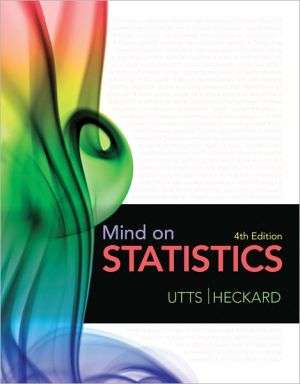

 |

|

Sold Out
Book Categories |
1. STATISTICS SUCCESS STORIES AND CAUTIONARY TALES. What Is Statistics? Eight Statistical Stories with Morals. The Common Elements in the Eight Stories. 2. TURNING DATA INTO INFORMATION. Raw Data. Types of Variables. Summarizing One or Two Categorical Variables. Exploring Features of Quantitative Data with Pictures. Numerical Summaries of Quantitative Variables. How to Handle Outliers. Bell-Shaped Distributions and Standard Deviations. Skillbuilder Applet: The Empirical Rule in Action. 3. RELATIONSHIPS BETWEEN QUANTITATIVE VARIABLES. Looking for Patterns with Scatterplots. Describing Linear Patterns with a Regression Line. Measuring Strength and Direction with Correlation. Regression and Correlation Difficulties and Disasters. Correlation Does Not Prove Causation. Skillbuilder Applet: Exploring Correlation. 4. RELATIONSHIPS BETWEEN CATEGORICAL VARIABLES. Displaying Relationships Between Categorical Variables. Risk, Relative Risk, and Misleading Statistics About Risk. The Effect of a Third Variable and Simpson's Paradox. Assessing the Statistical Significance of a 2 x 2 Table. 5. SAMPLING: SURVEYS AND HOW TO ASK QUESTIONS. Collecting and Using Sample Data Wisely. Margin of Error, Confidence Intervals, and Sample Size. Choosing a Simple Random Sample. Other Sampling Methods. Difficulties and Disasters in Sampling. How to Ask Survey Questions. Skillbuilder Applet: Random Sampling in Action. 6. GATHERING USEFUL DATA FOR EXAMINING RELATIONSHIPS. Speaking the Language of Research Studies. Designing a Good Experiment. Designing a Good Observational Study. Difficulties and Disasters in Experiments and Observational Studies. 7. PROBABILITY. Random Circumstances. Interpretations of Probability. Probability Definitions and Relationships. Basic Rules for Finding Probabilities. Finding Complicated Probabilities. Using Simulation to Estimate Probabilities. Flawed Intuitive Judgments About Probability. 8. RANDOM VARIABLES. What Is a Random Variable? Discrete Random Variables. Expectations for Random Variables. Binomial Random Variables. Continuous Random Variables. Normal Random Variables. Approximating Binomial Distribution Probabilities. Sums, Differences, and Combinations of Random Variables. 9. UNDERSTANDING SAMPLING DISTRIBUTIONS: STATISTICS AS RANDOM VARIABLES. Parameters, Statistics, and Statistical Inference. From Curiosity to Questions About Parameters. SD Module 0: An Overview of Sampling Distributions. SD Module 1: Sampling Distribution for One Sample Proportion. SD Module 2: Sampling Distribution for the Difference in Two Sample Proportions. SD Module 3: Sampling Distribution for One Sample Mean. SD Module 4: Sampling Distribution for the Sample Mean of Paired Differences. SD Module 5: Sampling Distribution for the Difference in Two Sample Means. Preparing for Statistical Inference: Standardized Statistics. Generalizations Beyond the Big Five. Skillbuilder Applet: Finding the Pattern in Sample Means. 10. ESTIMATING PROPORTIONS WITH CONFIDENCE. CI Module 0: An Overview of Confidence Intervals. CI Module 1: Confidence Interval for a Population Proportion. CI Module 2: Confidence Intervals for the Difference in Two Population Proportions. Using Confidence Intervals to Guide Decisions. 11. ESTIMATING MEANS WITH CONFIDENCE. Introduction to Confidence Intervals for Means. CI Module 3: Confidence Interval for One Population Mean. CI Module 4: Confidence Interval for the Population Mean of Paired Differences. CI Module 5: Confidence Interval for the Difference in Two Population Means (Independent Samples). Understanding Any Confidence Interval. Skillbuilder Applet: The Confidence Level in Action. 12. TESTING HYPOTHESES ABOUT PROPORTIONS. HT Module 0: An Overview of Hypothesis Testing. HT Module 1: Testing Hypotheses About a Population Proportion. HT Module 2: Testing Hypotheses About the Difference in Two Population Proportions. Sample Size, Statistical Significance, and Practical Importance. 13. TESTING HYPOTHESES ABOUT MEANS. Introduction to Hypothesis Tests for Means. HT Module 3: Testing Hypotheses about One Population Mean. HT Module 4: Testing Hypotheses about the Population Mean of Paired Differences. HT Module 5: Testing Hypotheses about the Difference in Two Population Means (Independent Samples). The Relationship Between Significance Tests and Confidence Intervals. Choosing an Appropriate Inference Procedure. Effect Size. Evaluating Significance in Research Reports. 14. INFERENCE ABOUT SIMPLE REGRESSION. Sample and Population Regression Models. Estimating the Standard Deviation for Regression. Inference About the Slope of a Linear Regression. Predicting y and Estimating Mean y at a Specific x. Checking Conditions for Using Regression Models for Inference. 15. MORE ABOUT INFERENCE FOR CATEGORICAL VARIABLES. The Chi-Square Test for Two-Way Tables. Analyzing 2 x 2 Tables. Testing Hypotheses About One Categorical Variable: Goodness-of-Fit. 16. ANALYSIS OF VARIANCE. Comparing Means with an ANOVA F-Test. Details of One-Way Analysis of Variance. Other Methods for Comparing Populations. Two-Way Analysis of Variance. 17. TURNING INFORMATION INTO WISDOM. Beyond the Data. Transforming Uncertainty Into Wisdom. Making Personal Decisions. Control of Societal Risks. Understanding Our World. Getting to Know You. Words to the Wise.
Login|Complaints|Blog|Games|Digital Media|Souls|Obituary|Contact Us|FAQ
CAN'T FIND WHAT YOU'RE LOOKING FOR? CLICK HERE!!! X
 You must be logged in to add to WishlistX
 This item is in your Wish ListX
 This item is in your CollectionMind on Statistics
X
 This Item is in Your InventoryMind on Statistics
X
 You must be logged in to review the productsX
 X
 X

Add Mind on Statistics, MIND ON STATISTICS helps you develop a conceptual understanding of statistical ideas and shows you how to find meaning in data. The authors—who are committed to changing any preconception you may have about statistics being boring—engage your curiosity wi, Mind on Statistics to the inventory that you are selling on WonderClubX
 X

Add Mind on Statistics, MIND ON STATISTICS helps you develop a conceptual understanding of statistical ideas and shows you how to find meaning in data. The authors—who are committed to changing any preconception you may have about statistics being boring—engage your curiosity wi, Mind on Statistics to your collection on WonderClub |